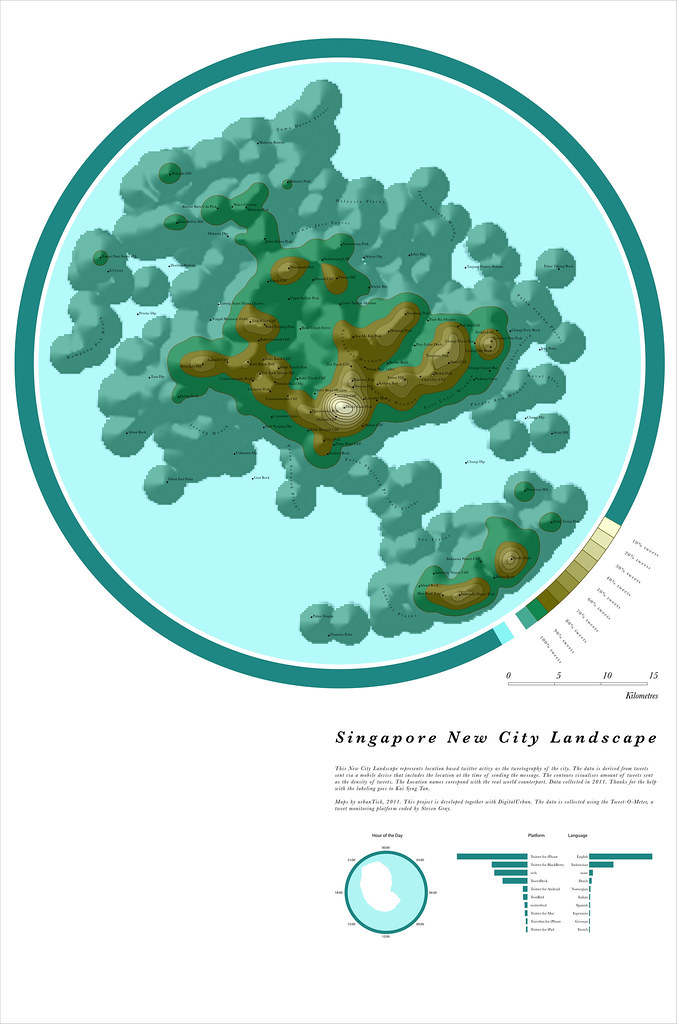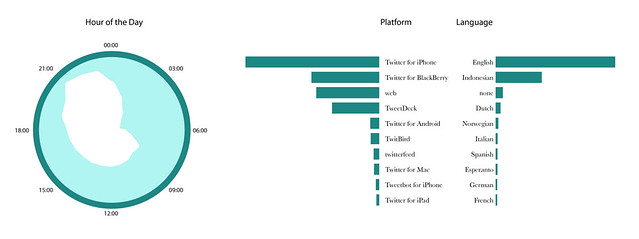New City Landscape – Singapore – one Island
Singapore is an city state with about 5’076’700 inhabitant according to the 2010 census. The society is very technology interested and electronics make a lot of their business.
Digital elements have a strong presence in everyday life, including online social networking. In this sense it is not surprising that Twitter is very popular in Singapore. Also in terms of location sharing, users in Singapore are quite happy to share their location with the tweets. We have about 46% of location based messages. This is only matched by Amsterdam, NL and Lagos, NG. The average over all the locations observed is about 10-12%.

Image by urbanTick for NCL / Singapore New City Landscape map generated from location based tweets collected over the period of one week. The area covered is within a 30 km radius of Singapore.
The virtual landscape redraws nicely the outline of the island state. There are the neighboring areas of Malaysia and Indonesia showing up at the top and the bottom respectively of the map. The connection across the water are also showing with tweets send either from a ferry crossing or from one of the two bridges. Beside these connection the international airport on the far most East corner of the island is probably even more important to connect to the outside. It features prominently in the landscape as a tall peak of high tweet activity.
Singapore New City Landscape
Image by urbanTick using the GMap Image Cutter / Singapore New City Landscape Use the Google Maps style zoom function in the top right corner to zoom into the map and explore it in detail. Explore areas you know close up and find new locations you have never heard of. Click HERE for a full screen view. The maps were created using our CASA Tweet-O-Meter, in association with DigitalUrban and coded by Steven Gray, this New City Landscape represents location based twitter activity. Thanks for the naming help to Kai from 3rdlifekaidie.
Overall the virtual landscape beautifully redraws the outline of the island Singapore is on. The main features that immediately stand out in the Singapore NCL map are the areas message are absent. The large Nature Reserve in the centre is the larges area with reduced Twitter activity, but also the live firing area and reserve on the western side of the island. In line with the other observed urban areas, outdoor spaces show lower Twitter activity.
On the other hand the complete south coast of the island is abuzz with activity. Ranging from Changi International Airport in the East all the way past the container ports to the West tot he industrial areas. The main peak is Dhoby Gaut Peak in the area of the major interchange station on the MRT.

Image by urbanTick for NCL / The rose shows the twitter activity per hour of the day, starting at 00:00 at the top, displayed as local time. Singapore is an evening city with a clear activity peak between 21h00 and 23h00. Mornings are very slow and it doesn’t really pick up until the late afternoon. The graphs show the platform of preference used to send the tweet and the language set respectively.
The languages represented in the Singapore data set are clearly dominated by English and Indonesian. Those two languages cover about 90% of all messages. Interestingly the other few languages featuring are European rather than Asian. There is Dutch, Norwegian, Italian and Spanish, German and French. Also Esperanto again features, though only with for marginal number of tweets.
The platform is dominated by twitter for iPhone, followed by twitter for Blackberry, the web and tweetDeck. The iPhone seems very popular in Singapore. Also the iPad features on the tenth rank with twitter for iPad.
The temporal structure of Twitter activity is extremely focused on the evening. No other city has such a strong activity preference as Singapore shows. There is a clear peak between 9pm and 11pm. with a extreme drop of after 1am to nearly zero activity between 4am and 5am. This is followed by a sharp start in the morning around 8am. Through out the day this stays about leveled until it starts to rise in the late afternoon after 6pm.
